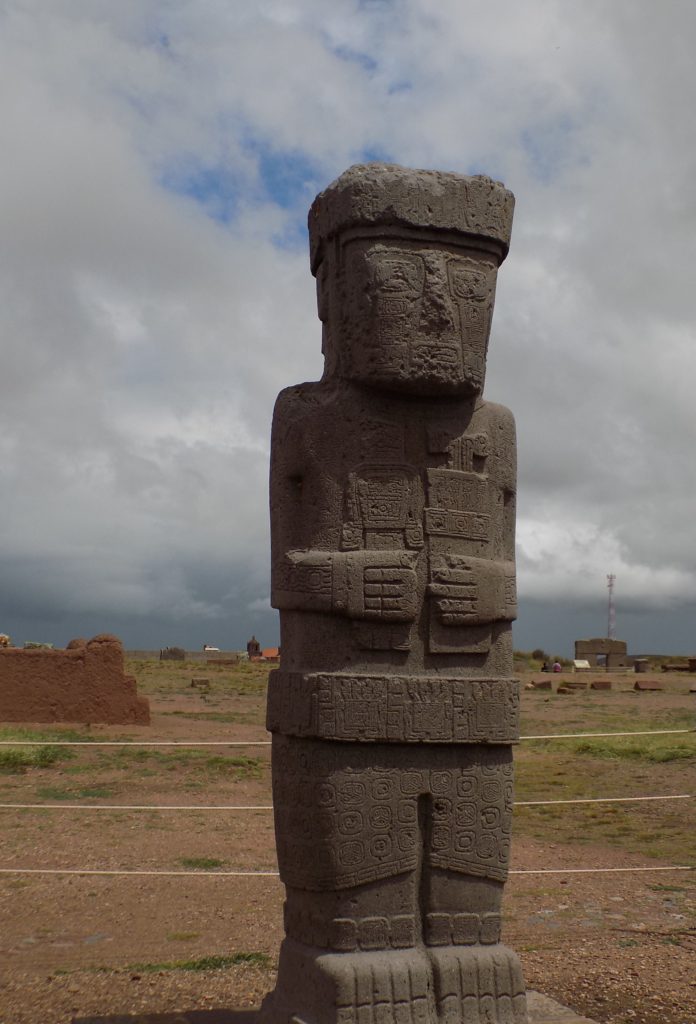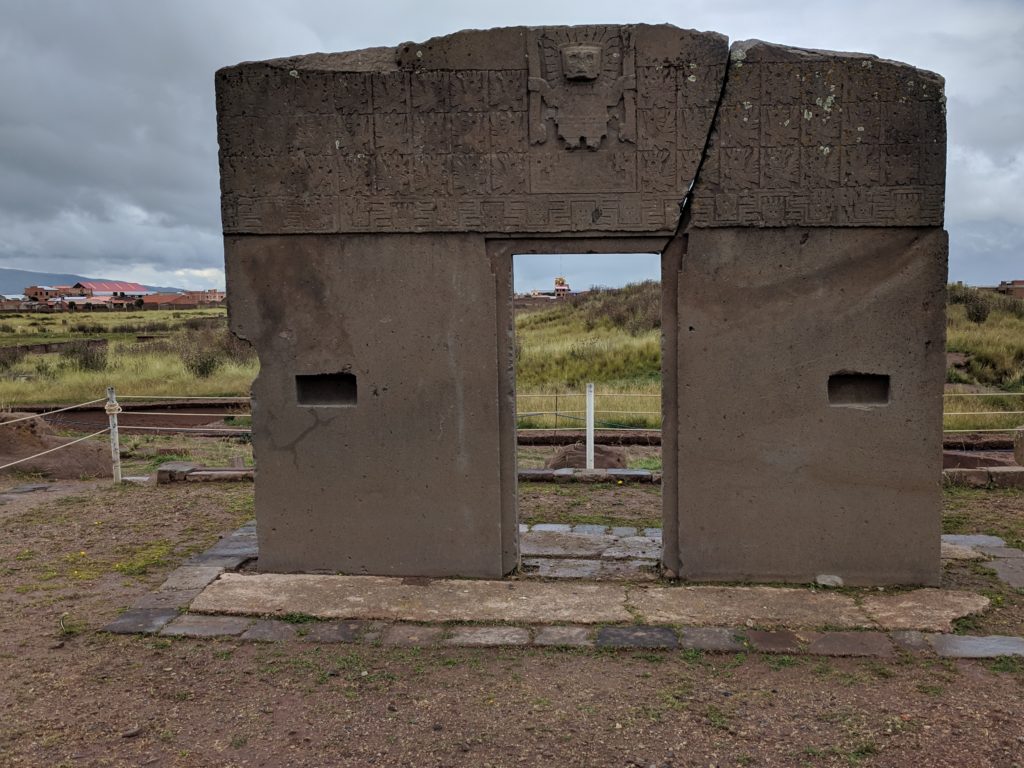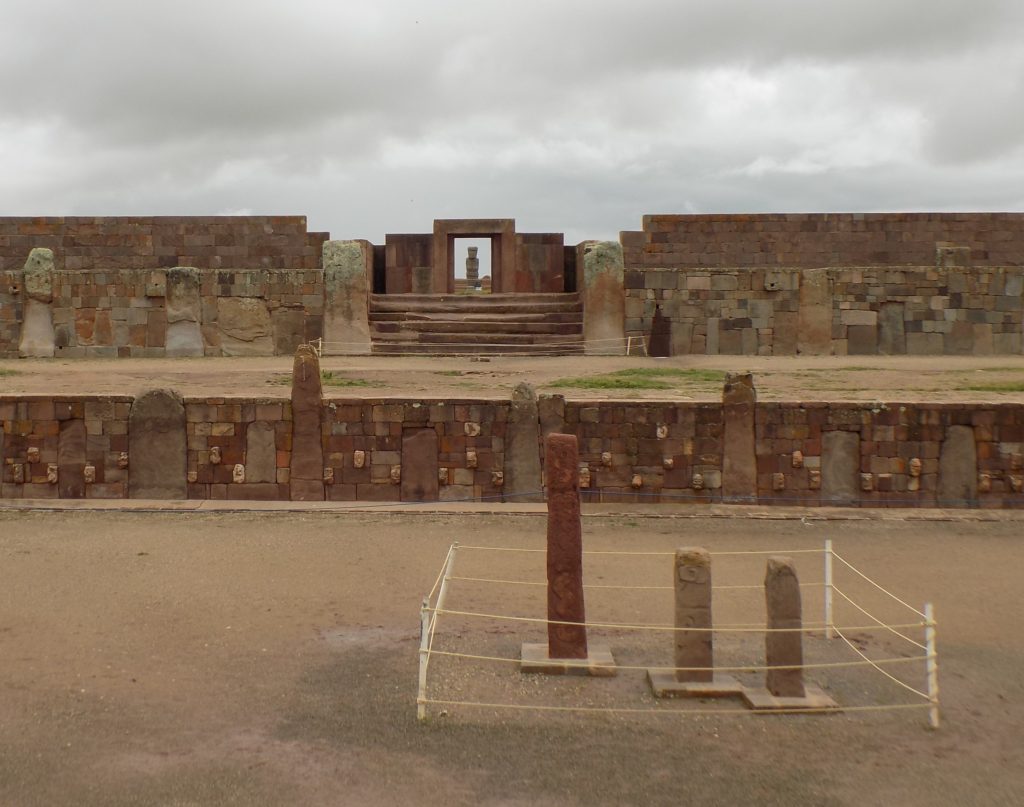The Akapana Pyramid.
Leaving the museum and entering the site proper, we came first to the Akapana Pyramid. In some ways, this man-made hill is at the center of one of the many mysteries surrounding Tiwanaku – from its actual name, to the extent of its influence to its possible connections with ancient Sumerians (which I won’t discuss but which you can, if you’re so inclined, read about at this very speculative history website), to the reasons it appears to have been suddenly abandoned.
The Akapana Temple was a seven-level pyramidal building made from large blocks of limestone and refined andesite. The remains we see today are rather amorphous due to erosion, looting, and the removal of its stones for use in constructing colonial churches and other buildings used in Tiahuanaco (the village of about 860 people near the site) today.
Its base is about 180 meters on each side and evokes the shape of the Chakana sometimes called the Andean or Inkan Cross. This detail appears throughout the presumed ceremonial center at the top of the mound – a flattened area about 50 meters square. While only 15 meters remain, the seven overlapping steps originally reached a height of about 35 meters.
One of the puzzling mysteries surrounding the pyramid is that it appears to have become the sole focus of the people there sometime around 700 CE. In this period, not only does all other construction in the city appear to have ceased, but the previous monuments of the city were being torn down and their stones reused to build the Akapana pyramid. As it is with much else, there’s no record to understand why this happened. Adding to the enigma, the city was abandoned and the temple never finished.
Walking through the Tiwanaku complex one notices two principal types of walls. Some have large irregular blocks and others are constructed with straight-edged blocks that fit together precisely. Archaeologists studying the site have noted grooves cut in many of the stones. In all likelihood, these grooves allowed for the placement of ropes which would have rendered the stones easier to transport and set in place. Blocks could be held together using metal clamps usually cast directly into T and I-shaped sockets in the stone. The precision cutting suggests the builders combined sophisticated cutting and measurement tools.
The Inkas are now known to have been great appropriators and refiners of useful elements from other cultures they encountered and often conquered or absorbed. Thus, it’s possible that when the great Inka Emperor Pachakutiq ‘Inka Yupanki encountered the abandoned site he might have taken close note of the assembly of the stone blocks joined by a series of dovetail joints that guaranteed a perfect seal. There are indications in the archaeological record that many Inka stonemasons were from the Lake Titikaka region and were responsible for cutting stones to fit together perfectly without mortar. This technique was also mastered by the Inkas as we shall see later in the trip.
Kalasasaya Temple.
The Kalasasaya Temple covers an area of about two hectares oriented to the cardinal points. On the winter solstice the sun rises over the northeast corner of the temple and over the southeast corner at the summer solstice. On the equinoxes the sunrise can be seen through the central portal leading archaeologists to conclude that, in addition to being a space for public and religious ceremonies, it was also used as an observatory.
Two large carved monoliths stand in the interior with the most striking being the three-and-a-half-meter-tall Ponce Monolith. Whether he represents a ruler, a High Priest, or a guardian of Tiwanaku, he casts an imposing presence over this large open space.
Another monument in the Kalasasaya Temple is, perhaps the most famous structure of Tiwanaku, the Puerta del Sol or Gate of the Sun. It presently stands in the northwest corner of the temple though this was not its original location.
Carved from a single block of andesite, the Gateway is 2.8 meters high and 3.8 meters wide. Like many of the objects at Tiwanaku, the Puerta del Sol was in great disrepair for many centuries and it required great effort to restore it to some semblance of its original appearance. It’s assumed that the central figure is a deity but it’s an open debate whether it is a deity from the Chavin culture or the Andean creator god Viracocha.
(Special thanks to Jan whose photo is better than any of mine.)
The Subterranean Temple.
Given that it’s only two meters below the surface I’m not certain this moniker is as precise as it could be for the 28-meter by 26-meter rectangular space. However, as the photo shows, it has a clear relationship with the Kalasasaya Temple.
It’s also the original location of the Bennett Monolith now housed in the museum.
Among the most notable features of this temple are the carved stone heads set into the 48 pillars of red sandstone that comprise the walls of the temple. Some assert that they see African, Asian, Semitic, and Caucasian features in some of the heads and they take that as another indication that the people of Tiwanaku welcomed travelers from distant places or were themselves travelers.
Before ending the day, we’ll encounter one final mystery and, perhaps unveil the secret behind a more modern development in Bolivia.




